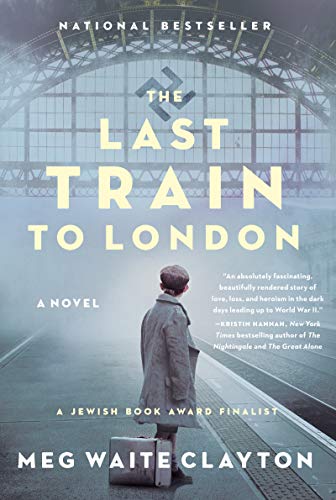The Last Train to London is a book that casts you back to the days before World War II. Welcome to this review, folks! I gotta say, this book paints the era so well that I almost believed I time-traveled. It’s a brave tale of heroism, unfolding with slow but steady pacing. But don’t worry, once you meet characters like Truus Wijsmuller, you’ll be hooked. The storytelling pulls at your heartstrings, although it occasionally throws enough characters at you to start your own parade. Get ready to explore the good, the not-so-good, and the somber truth of this historical drama.
In a nutshell
‘The Last Train to London’ by Meg Waite Clayton is a historical fiction novel set in the tumultuous pre-World War II era. It showcases the heroic efforts of Truus Wijsmuller, a real-life Dutch woman who risked her life to smuggle Jewish children out of Nazi-occupied territories to safety. Themes of bravery, sacrifice, and the power of human compassion are woven throughout the narrative. It’s a slow-paced yet gripping story that highlights a lesser-known part of history, offering a poignant reminder of the resilience of the human spirit.
Historical Context and Accuracy of The Last Train to London
There’s something about historical novels that piques my interest. ‘The Last Train to London’ hits the nail on the head when it comes to historical context. The book takes us back to late 1930s Europe, a time when the world was on a tightrope, balancing on the edge of war. I found myself in awe of the meticulous attention to detail that Meg Waite Clayton put into this novel. It’s as if she had a time machine to gather all the nitty-gritty deets!
There are moments in the book where you almost hear the clamor of train wheels on tracks as Vienna and London come alive with intrigue. It’s no easy feat to write about a period that was, quite frankly, a real mixed bag of emotions. You have Nazi occupation, the Kindertransport, and all the harrowing decisions individuals had to make. The book holds up well against these historical realities and offers a heart-wrenching yet accurate portrayal.
But, let’s be real, it’s not all sunshine in the history department. Some folks might get their knickers in a twist over certain creative liberties taken with characters or events. Still, the essence of the time is captured so vividly, it makes history feel like a juicier-than-usual lesson. So, while I’d gladly give Clayton an A+ for her historical gusto, do keep an eye out for these little fictional flourishes.
Now, ready yourself for the next train stop: Character development and how engaging they are!
Character Development and Engagement in ‘The Last Train to London’
Let me tell ya, ‘The Last Train to London’ is like a theatrical play on paper with all its characters vying for the spotlight. We meet Truus Wijsmuller, a courageous Dutchwoman with more spunk than a triple shot of espresso. I mean, this lady has nerve! She’s on a mission to save kiddos from the clutches of the Nazis. If that ain’t hero material, I don’t know what is. Author Meg Waite Clayton doesn’t just sketch out characters, she plops them down beside you on the couch. It feels like they’re in your living room, munching on your snacks and spilling their tea!
Every character is more layered than my mom’s infamous lasagna. The kids are the heart of the story. Stephan, the young Jewish boy, made me wanna reach through the pages and give him a comforting hug. His dreams and fears feel so real, I almost booked a train ticket myself! The way Clayton crafts their journeys, you can’t help but get attached. It’s like you have legal guardianship over strangers. That’s solid character engagement for you!
But hey, not all is tip-top. At times, the sheer number of characters makes it feel like a Where’s Waldo book. You might lose track faster than I lose my car keys. Yet, the emotional investment is worth it, and the characters deliver pulse-raising moments like they work for the emergency room. Now that we’ve unpacked the lively cast, let’s unravel the emotional impact and storytelling, where the heartstrings get a workout!
The Emotional Rollercoaster and Storytelling Brilliance in ‘The Last Train to London’
I once cried at a puppy commercial, so you can guess how ‘The Last Train to London’ hit me right in the feels. This book packs an emotional punch so strong, it would knock out a heavyweight champ. The story weaves through the harrowing experiences of Jewish children escaping Nazi-occupied Vienna, and from page one, it grabs you by the heartstrings and doesn’t let go. Now, I’m not saying you need tissues, but you might want to have some handy, just in case.
What really stands out is the authenticity of the storytelling. Meg Waite Clayton brings to life a vivid tapestry of courage and fear, hope and despair. She paints such a real picture, it’s almost like you can feel the chalky grit of the train station under your feet. The characters’ emotions leap off the page, and I often found myself rooting for them like they were my own friends in a dire escape room – unlock that door, folks!
The narrative flows smoothly, making it easy for readers to connect with the characters and their plights. And while the emotional impact is hefty, it never feels manipulative or overdone. Instead, the story resonates with a poignancy that stays with you long after you’ve turned the last page. The emotional truths Clayton reveals will make you reflect on human resilience and the power of kindness even in the darkest times.
Hold your train tickets tight, because coming up next, in our journey with ‘The Last Train to London’, we’ll explore how its writing style and pacing keep the engine chugging along.
Writing Style and Pacing of ‘The Last Train to London’
I once tried to sprint to catch my morning train. Turns out, middle-aged Steve isn’t as spry as he used to be! Just like my frantic dash, ‘The Last Train to London’ by Meg Waite Clayton has its own rhythm that may not be everyone’s cup of tea.
Reading this book, I felt like I was on a cosmic voyage—a slow yet captivating journey through time. Clayton’s style is rich in detail, painting a vivid picture of pre-war Europe. You find yourself immersed in the world of the 1930s, as if you’ve teleported there, sans the time machine. Her use of descriptive language lets the reader smell the train smoke and feel the moral urgency of the era.
However, the pacing can be as leisurely as grandpa’s storytelling—comforting yet sometimes a little too drawn out. There were moments I found myself flipping back pages. Was it me or did it just time travel back two chapters? Yes, some parts linger a bit too long, especially if you are billed for a shorter reading experience.
Despite the unhurried pacing, Clayton does a stellar job weaving multiple threads into a cohesive narrative. This style suits the subject matter beautifully, though you might feel like napping once or twice. Kind of like when my cat, Mittens, naps during a marathon nap session.
So, do I recommend ‘The Last Train to London’? I say, buy the ticket, and take the ride! Just bring some patience along for the journey. It’s worth it.
Conclusion
So, wrapping it up, ‘The Last Train to London’ is a powerful tale of courage and sacrifice set against the backdrop of pre-WWII Europe. The book’s real strength lies in its historical accuracy and emotional depth, especially through the character of Truus Wijsmuller. However, the pace can be a bit sluggish, and the complex arcs may sometimes feel overwhelming. It’s a captivating read for those interested in historical fiction, but not one for those seeking light entertainment. You might need a box of tissues too. Happy reading!



